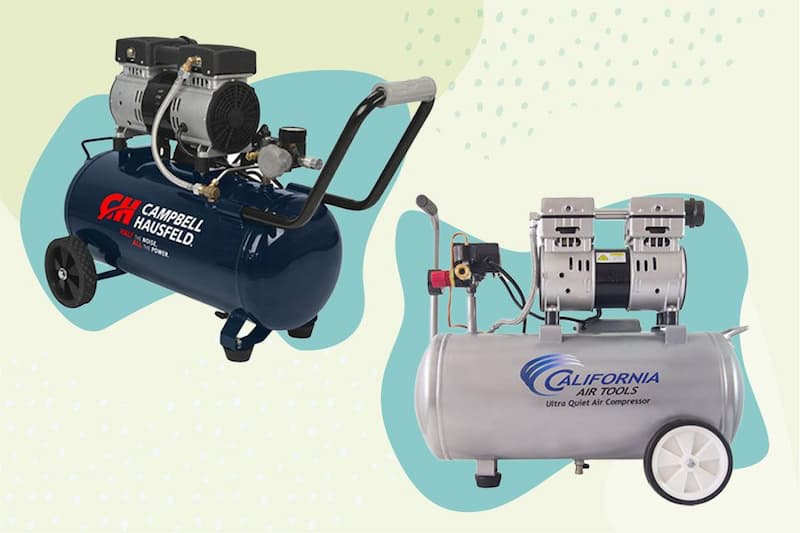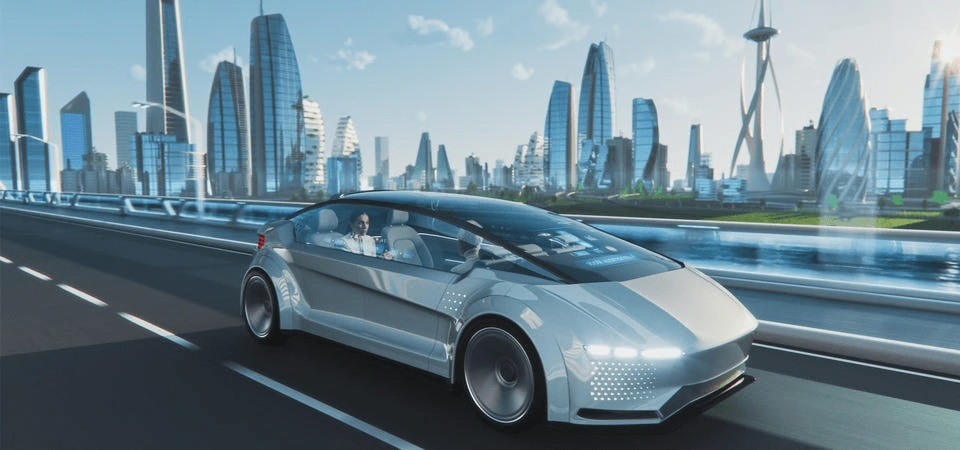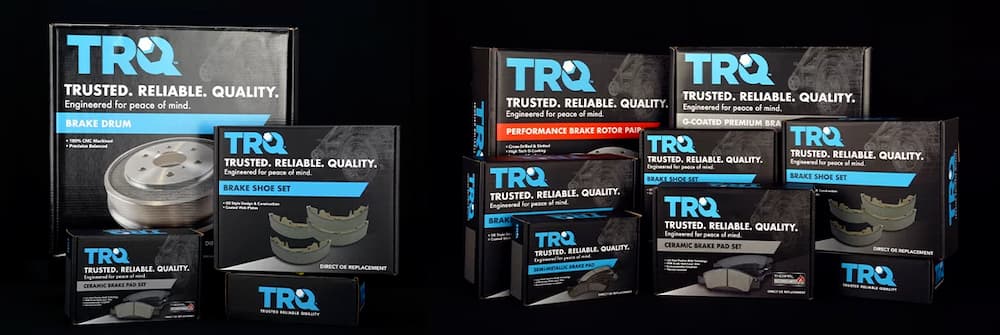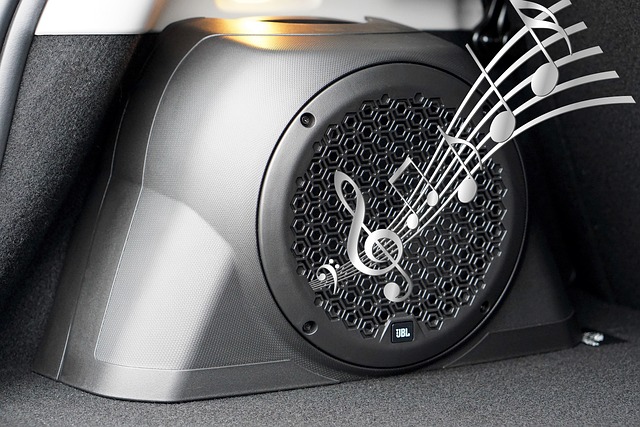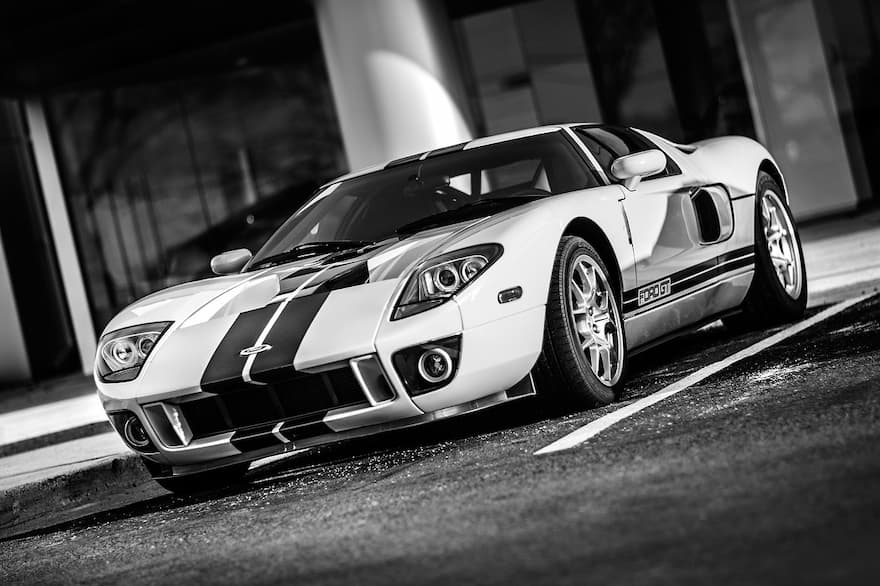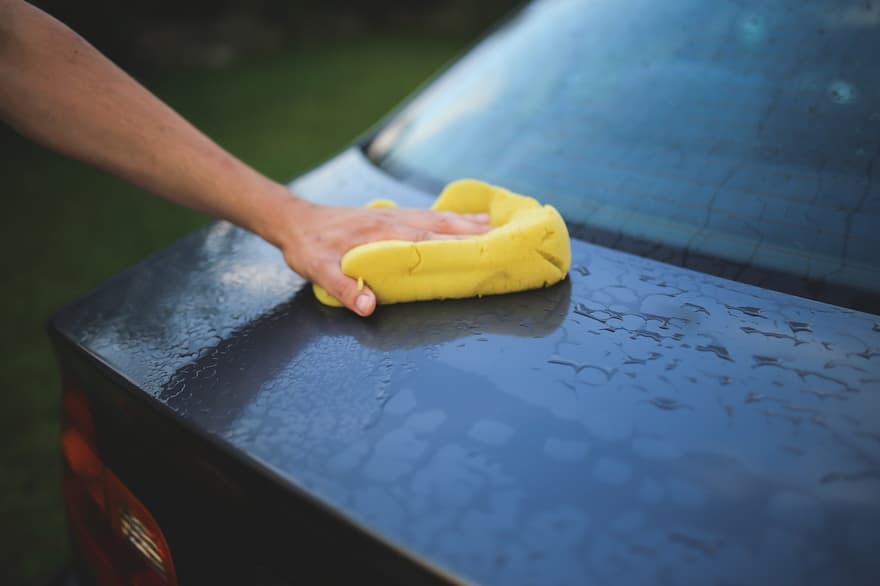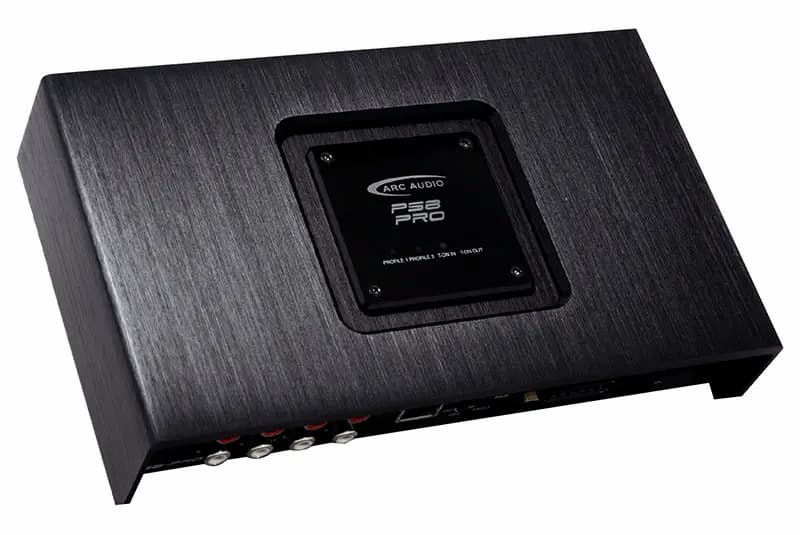What is the best air compressor for painting cars?
It can be difficult to choose the best air compressors for automotive paint sprayers. It can be obvious which models might be suitable for you when you take the appropriate factors into account.
We can assist you in locating the ideal air compressor for your needs. You’ll be able to finish your job in a fraction of the time when you find the right air compressor and spray gun.
Continue reading to learn more about the ideal air compressor for painting automobiles.
Table of Contents
Can An Air Compressor Be Used To Paint Cars?
Yes, painting cars is a legitimate use for an air compressor. Without visiting a body shop, it is a great way to give your car a polished appearance. When painting cars with a compressor, make sure to use high-quality paint and adhere to the manufacturer’s instructions.
Best Air Compressor For Painting Cars
Ingersoll Rand 2340l5-V (Best Overall)
- Power: 230 volts, 5 horsepower
- Tank Size: 60 gallons
- CFM/PSI: 14.3 CFM at 175 PSI
- Max. Pressure: 175 PSI
- Weight: 400 pounds
The 2340L5-V from Ingersoll Rand tops the list and stands out for being simple to maintain. This design features a connecting rod made of one piece, an overhung crankshaft, and individually cast cylinders. Due to their accessibility, repairs and replacements are made simpler with these.
A 2-stage air compressor, a 60-gallon tank, and a heavy-duty 5 HP motor are also included in the product’s setup, which together can produce a maximum pressure of 175 PSI. Most pneumatic tools, even the most demanding ones, can be operated with this amount of power.
Additional features include a long-lasting cast iron construction, a finned copper intercooler for heat dissipation, and a long-lasting pump that is intended to run trouble-free for 15,000 hours.
The drawbacks of this pump include its 400-pound weight, the periodic need for lubrication, which makes maintenance somewhat laborious.
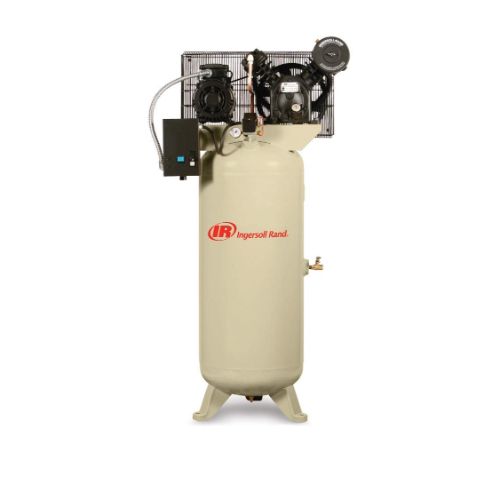
Pros:
- Easy-to-service design
- Heavy-duty 5 HP motor with a high max pressure of 175 PSI
- Durable cast iron construction
- Finned copper intercooler for effective heat dissipation
Cons:
- Quite heavy
- Requires lubrication
Dewalt Dxcmla3706056 (Best Budget)
- Power: 230 volts, 3.7 horsepower
- Tank Size: 60 gallons
- CFM/PSI: 11.5 and 13.4 CFM at 90 and 40 PSI
- Max. Pressure: 155 PSI
- Weight: 247 pounds
This DeWalt air compressor is the best choice to take into account if you have a limited budget. Nevertheless, the unit comes with synthetic oil to maintain the lubrication of its single-stage pump and has a tank that is about 60 gallons in size, which allows for longer run times.
In this configuration, you can achieve flow rates of 11.5 and 13.4 CFM at 90 and 40 PSI, respectively. This is sufficient to power a variety of pneumatic tools, including ratchets, spray guns, hammers, impact wrenches, and many others.
Other features include pressure gauges for monitoring and control, an on/off switch, a sturdy cast-iron construction with an aluminum head and valve plate for quick heat dissipation, and an oil level sight glass for simple monitoring.
But this compressor lacks wheels, making it difficult to move around.
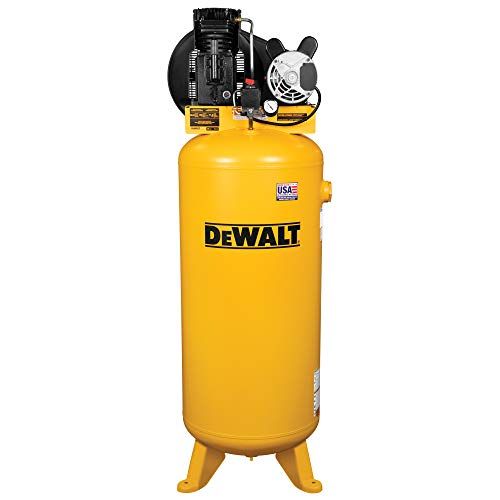
Pros:
- Affordable
- Comes with synthetic oil for keeping the pump lubricated
- Pressure gauges and an on/off switch for control
- Oil level sight for easy monitoring
Cons:
- Lacks a set of wheels
Campbell Hausfeld VT6271 (Best Portable)
- Power: 240 volts, 3.7 horsepower
- Tank Size: 30 gallons
- CFM/PSI: 10.2 CFM at 90 PSI
- Max. Pressure: 135 PSI
- Weight: 163 pounds
This horizontal air compressor has a user-friendly design and is portable thanks to its handle and two wheels. Additionally, the unit is very lightweight at only 163 pounds, which makes transporting it much simpler.
However, the tool has a 240-volt. 3.7 horsepower plus a relatively small 30-gallon reserve tank, which results in a relatively lower flow rate of 10.2 CFM at a maximum pressure of 135 PSI and 90 PSI.
You can still use a variety of tools, including staplers, sanders, and grinders, among many others, with this amount of power.
The horizontal shape of this compressor’s tank has the drawback of requiring a lot of floor space.
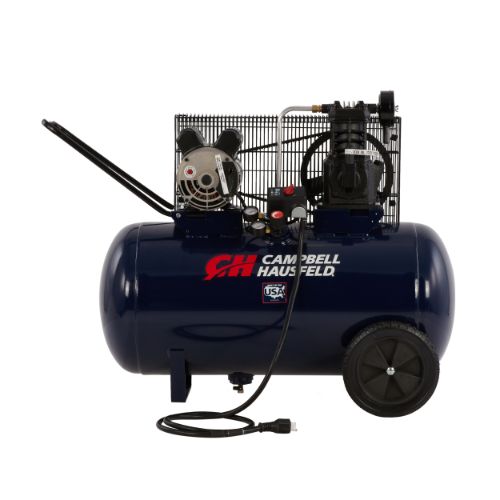
Pros:
- Handle and two wheels for easy movement
- Lightweight design
- Suitable for powering different tools
Cons:
- Horizontal design consumes a lot of floor space
- Relatively small 30-gallon reserve tank
Ingersoll Rand 2340N5-V (Most Powerful)
- Power: 230 volts, 5 horsepower
- Tank Size: 80 gallons
- CFM/PSI: 14.3 CFM at 175 PSI
- Max. Pressure: 175 PSI
- Weight: 475 pounds
Ingersoll Rand’s 2340N5-V is a solid choice to take into consideration if you’re looking for a strong air compressor to power your paint sprayer. This is due to its 3-phase, 230-volt, 5 HP motor, which drives a 2-stage motor to produce a maximum pressure of 175 PSI.
This compressor can be used to power a wide range of pneumatic tools in automotive body shops, woodworking, production lines, auto service, and many other settings thanks to its high maximum pressure and large 80-gallon tank.
A sturdy cast iron construction and a sturdy pump with a 15,000-hour expected lifespan are additional features.
On the negative side, this compressor is very pricey and heavy, which limits how portable it is.
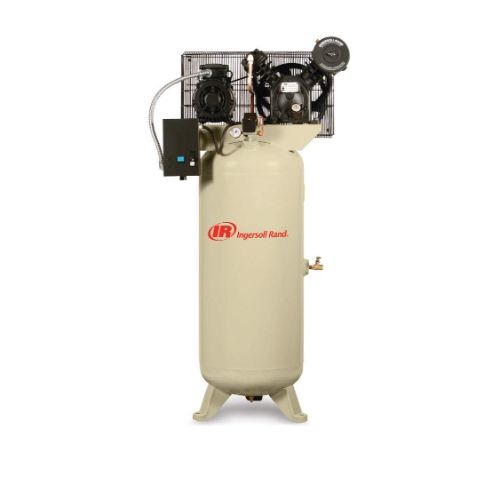
Pros:
- Powerful 5 HP motor and a 2-stage motor for high-pressure output
- Large 80-gallon tank
- Durable cast iron construction
- Designed for long-lasting, 15,000-hour trouble-free use
Cons:
- Heavy
- Expensive
Powermate VX PLA4708065 (Largest Capacity)
- Power: 240 volts, 4.7 horsepower
- Tank Size: 80 gallons
- CFM/PSI: 14 and 16.1 CFM at 90 and 40 PSI
- Max. Pressure: 155 PSI
- Weight: 354 pounds
Powermate Vx’s PLA4708065 has a large 80-gallon tank that can hold enough air to operate effectively at peak demands. Because the tank is made of steel, it is incredibly sturdy and long-lasting.
An electric motor running at 240 volts and 15 amps compresses air at a rate of 14 CFM at 90 psi and 16.1 CFM at 40 psi, producing 4.7 horsepower at the maximum pressure of 155 psi. The device can be used to power tools like impact wrenches, spray guns, ratchets, and hammers with this output.
Other features include a strong, one-piece cast iron crankcase and cylinder body, built-in tank pressure gauges, an on/off switch for control, and a wired belt guard that covers the moving parts, protects them, and enhances cooling.
The compressor’s pump does need to be lubricated occasionally, which makes upkeep a little difficult. For ease of movement, there are no attached wheels.
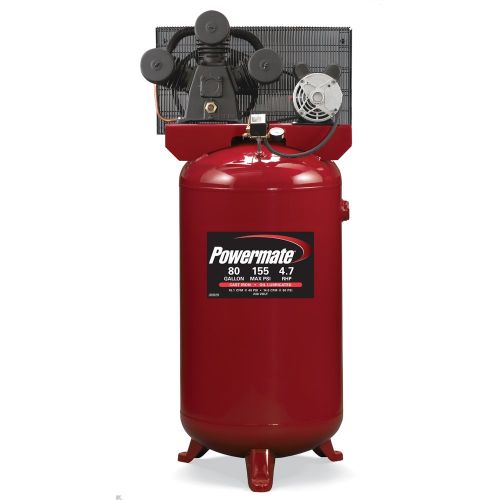
Pros:
- Large capacity 80-gallon reservoir tank
- Compatible with ratchets, hammers, impact wrenches, and spray guns
- Durable 1-piece cast iron crankcase and cylinder body
- Wired belt guard
Cons:
- No wheels for easy movement
- Requires lubrication
Industrial Air Ila3606056 (Heavy-duty)
- Power: 240 volts, 3.7 horsepower
- Tank Size: 60 gallons
- CFM/PSI: 11.5 and 13.4 CFM at 90 and 40 PSI
- Max. Pressure: 155 PSI
- Weight: 247 pounds
The ILA3606056 from Industrial Air is constructed with heavy-duty parts for long-lasting use, such as a single-piece cast iron crankcase, a thermally stable cast iron cylinder body, Swedish stainless-steel reed valves, and automotive-style ball bearings.
There is also a powerful 3.7 horsepower, heavy-duty 240-volt induction motor that drives a 155 maximum PSI pump that produces 11.5 and 13.4 CFM at 90 and 40 PSI, respectively. Multiple air tools, including hammers, ratchets, impacts, and spray guns, can now be powered by this.
A 60-gallon reserve tank, pressure gauges, and an on/off switch for simple control are also included. However, there are no built-in wheels for simple movement, and lubricating the pump on a regular basis makes maintenance a little challenging.
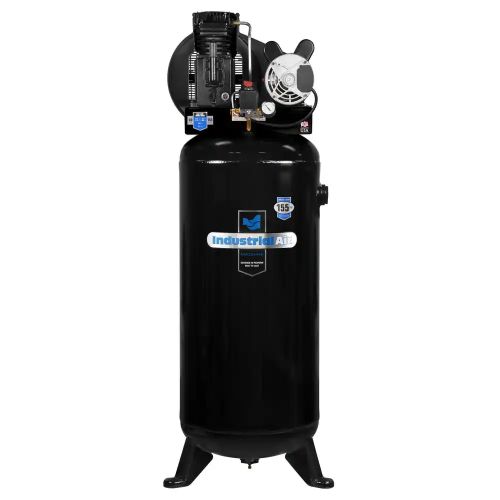
Pros:
- Heavy-duty components for long-lasting use
- Ideal for running multiple air tools
- Pressure gauges and an on/off switch for easy control
Cons:
- No wheels
- Requires lubrication
California Air Tools Cat-60040CAD (Easy-to-maintain)
- Power: 220 volts, 4 horsepower
- Tank Size: 60 gallons
- CFM/PSI: 10.6 and 12.8 CFM at 90 and 40 PSI
- Max. Pressure: 125 PSI
- Weight: 213 pounds
This auto painting air compressor is quite special because it has an oil-free dual piston pump that is simple to maintain and results in lower operating costs because you won’t need to purchase lubricating oil.
Other than that, the mechanism is made to operate very quietly and is equipped with two motors, each rated at 2 HP (a total of 4 HP).
A flushing toilet produces a sound that is 75 decibels louder than the noise being made in actuality.
Additionally, you receive a 60-gallon tank that can be filled in 6.5 minutes and a thermal overload protector to prevent the motors from being harmed by voltage variations.
The oil-free pump on this compressor, however, lasts only 3000 hours before it starts to wear out, and it is very expensive.
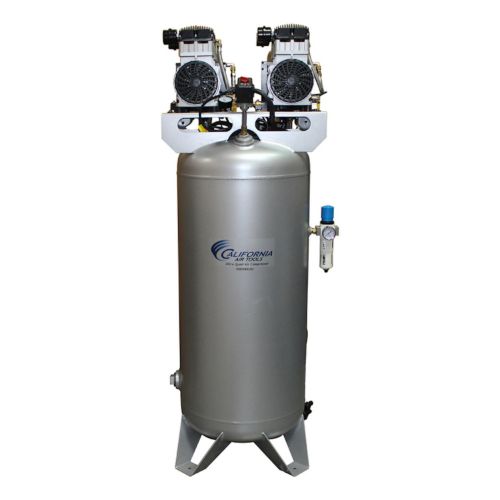
Pros:
- Easy-to-maintain oil-free pump
- Operates quietly with a noise output of only 75dB
- Low operation costs (no oil required)
- Thermal overload protection
Cons:
- Relatively low 3000-hour lifespan before wear
- Expensive
Dewalt DXCMV 5048055 (Most Efficient)
- Power: 230 volts, 5 horsepower
- Tank Size: 80 gallons
- CFM/PSI: 17 and 17.9 CFM at 175 and 100 PSI
- Max. Pressure: 175 PSI
- Weight: 470 pounds
The efficiency of DeWalt’s DXCMV5048055 is enhanced by its patented 2-stage pump and piston design, which includes deep groove directional and asymmetrical cooling fins, as well as a cast-iron flywheel with substantial fins.
Together, these parts ensure rapid heat dissipation, allowing the machine to operate at a cooler temperature for extremely effective compression.
The tool also has thermal overload protection, which guards against voltage fluctuations harming the powerful 5 HP motor.
You receive an integrated control panel with an airflow regulator, pressure gauges, a pressure relief valve, two quick-connect air outlets for control, and a sizable 80-gallon tank. The only drawbacks to this tool are that it is quite heavy and lacks wheels for easy mobility.
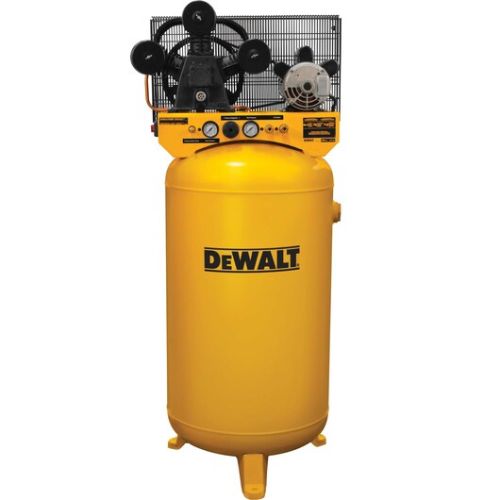
Pros:
- Patented fin design for cooler running
- Thermal overload protection safeguards against voltage fluctuations
- Powerful 5 HP motor
- Integrated control panel for monitoring the air pressure
Cons:
- No wheels
- Heavy
Campbell Hausfeld XC602100 (2-stage)
- Power: 240 volts, 3.7 horsepower
- Tank Size: 60 gallons
- CFM/PSI: 11 CFM at 90 PSI
- Max. Pressure: 175 PSI
- Weight: 336 pounds
The XC602100 from Campbell Hausfeld, which has a 2-stage pump that delivers highly pressurized air and can deliver a maximum pressure of 175 PSI, completes the list.
This allows for the use of a variety of tools, and the 3.7 HP heavy-duty induction motor is also included to maintain long run times for reliable compression performance.
Another advantage of the 2-stage pump is its long lifespan of up to 5,000 hours. It also operates very quietly and smoothly.
Additionally, it has a vertical 60-gallon tank that takes up less floor space and has a flow rate of 11 CFM at 90 PSI. You do not, however, receive wheels for mobility.
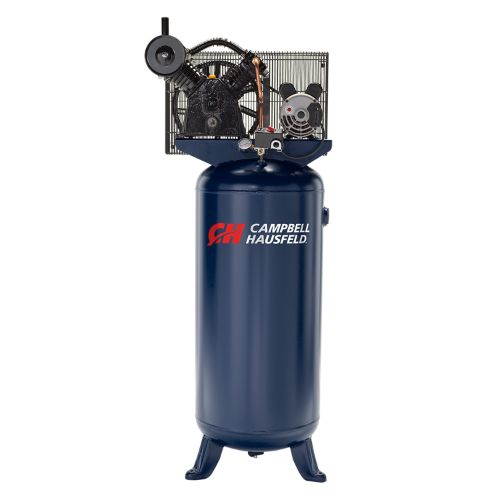
Pros:
- 2-stage pump; delivers a high 175 PSI max pressure
- Smooth and quiet running
- 3.7 HP heavy-duty induction motor gives longer runtimes
- Vertical design; takes up less floor space
Cons:
- No wheels
Craftsman Cmec6150k 6 Gallon Oil-free Air Compressor
- 6 Gallon tank size
- 150 PSI air pressure
- Oil-free pump
- 32 lbs weight
- 13 Piece Accessory Kit
- 1-year warranty
- Pancake shape
A high-quality air compressor for painting cars is the CRAFTSMAN CMEC6150K compressor. It provides an oil-free pump to reduce operating maintenance.
With a 6-gallon capacity and 150 PSI of air pressure, it has a lot of power. We can move this portable air compressor around with ease thanks to its pancake shape and handle design.
A coupling, plug assembly, PVC air compressor hose, and three inflator adapters are among the 13 items in the accessory kit that come with this compressor. The warranty for Craftsman air compressors is one year. This air compressor is reliable and can be used for extended periods of time.
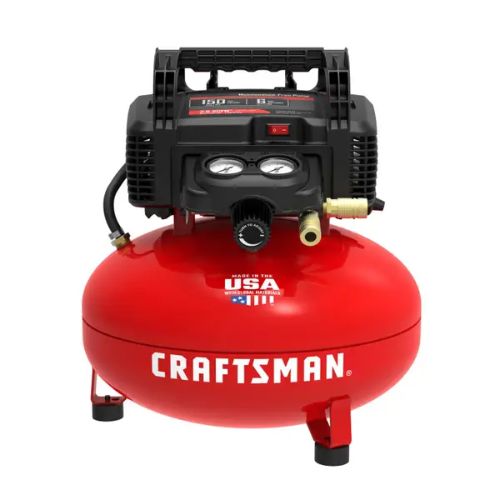
Pros:
- Oil-free pump
- Lightweight and portable
- Accessory Kit
Cons:
- Slightly Noisy
How Does An Air Compressor Work For Painting Cars?
A machine called an air compressor compresses air to create a climate that is perfect for painting cars. Painting with an air compressor is quicker and results in a more even coat than using a traditional method like a brush or roller.
The air compressor first pulls ambient air from the surrounding area before compressing it inside the device. By increasing air pressure through compression, micro-atmospheres are produced that are perfect for painting cars. When you’re ready to start painting, just connect your paint gun to the compressed air outlet and spray away!
What Size Air Compressor Works Best For Painting A Car?
When selecting an air compressor, size is an important consideration. A larger air compressor can typically supply more gallons of air to an automotive paint sprayer. The size of the compressor you will buy depends on the size of the vehicle as well.
30 to 50 gallons are sufficient for you if you drive a coupe or sedan. A tank capacity of 50 to 60 gallons is required for an SUV or small truck.
To completely cover the outside trailer on a vehicle like a truck, you will need 70 gallons or more. The bottom line is that you must first determine the type of vehicle before selecting the ideal air compressor to paint it.
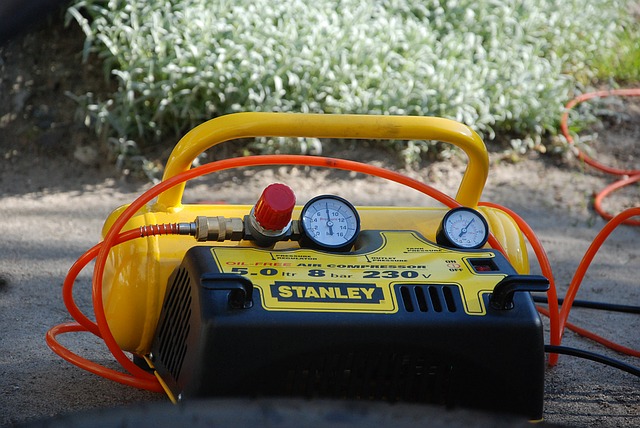
How Can An Air Compressor Be Used With A Spray Gun?
If you want to paint your car perfectly with an air compressor. You must be aware of how to assemble an air compressor and spray gun.
The right settings will ease your workload. A slight decrease in volume or pressure in the spray gun will result in poor paint quality on the car.
Painting an air compressor with a spray gun is simple to do with the right tools and setup.
You can set up an air compressor with a spray gun using the information in this guide.
- Understands the Components
Understanding how the different parts are used and how they function is the first step in setting up the air compressor with your spray gun. Here we have a compressor, a regulator, an air hose, a filter, and a spray gun. For the correct setting up of these devices, read the user manual.
- Ensure Proper Measurement of Air Hose
If your hose is too long or too narrow, it may lead to pressure issues. Air will flow less freely through an air hose with a narrower bore. Your spray gun will receive less air pressure as a result. A hose with a larger diameter will exert more pressure than one with a smaller diameter. To minimize airflow restriction, the inside diameter and tubing length must be properly balanced.
- Minimize Quick disconnect fittings (QDs)
Always select a QD with a small number and a large diameter to ensure minimal pressure loss, depending on the design and volume requirements of your pressure spray gun. Large diameter QDs are thought to be the least constrictive and most practical if you want the best outcomes.
- Use High-Quality Air Regulators
In order to ensure consistent results, air spray gun regulators are used to adjust airflow and pressure. However, due to this design, airflow may also be constrained, leading to an excessive pressure drop. Paint gun filter regulators come in two varieties: wall-mounted and gun-mounted.
Larger wall-mounted regulators typically produce more air pressure for the spray gun and reduce the dreaded pressure drop.
How To Choose The Best Air Compressor For Painting Cars?
Before buying an air compressor to paint cars, you should take the following factors into account.
- Cubic Feet per Minute
One of the most crucial things to take into account before purchasing an air compressor is the CFM. In most cases, it refers to the rate at which an air compressor can deliver a specific volume of air at a specific pressure level. An air compressor is better if its CFM value is higher.
The trick is to determine how much CFM your spray gun needs, and then select an air compressor that offers a higher value of cubic feet per minute. You won’t get the performance you need if the sprayer’s specifications aren’t met. If you choose the proper CMF value, paint splatter and/or uneven coating will never be a concern.
- Power
Regarding power, there are two things you need to look at. Power rating and voltage are these.
The better option is an air compressor with a higher horsepower. This is so because a higher HP rating corresponds to a higher compression, which causes a rapid flow rate and maximum pressure.
Since many air compressors are electric, you should check their voltage rating before purchasing. Keep in mind that some stages have standards between 110 and 120 volts. Some have electrical grids with voltages between 220 and 240. You might need to purchase an adapter for compatibility depending on where you live.
- Size of the Tank
Some claim that the air compressor is better the bigger the tank. However, that is largely relative and subjective. If you stop to consider it, your needs and those of another person are different. Therefore, the size of the tank that is ideal for you might not be for someone else.
If you have a ton of difficult car painting jobs, get the biggest tank. The best option in this situation would be an air compressor with an 80-gallon tank. However, if you’re a mechanic or DIY enthusiast who enjoys doing small painting projects, an air compressor with a 30-gallon tank should be adequate.
- Pressure
Before purchasing, find out how much PSI an air compressor can deliver because spray guns need pressure to function. The PSI value is again better the higher. In fact, using a higher PSI air compressor will allow you to work with a variety of power tools with no problems.
Pros of Using An Air Compressor for Painting Cars
Many auto body shops always have air compressors on hand. Inflating tires and powering air tools are just two of the many uses for them. But did you know that air compressors can also be used to paint automobiles?
In actuality, there are several advantages to using an air compressor when painting. Here are just a few:
Better Paint Coverage
Having a better paint coverage is one advantage of using an air compressor when painting. It is simple to miss areas when using a traditional paintbrush or to produce streaky brushstrokes. However, when you use an air compressor, the paint is sprayed onto the surface of the car uniformly and smoothly, providing better coverage and a more professional-looking finish.
Faster Paint Drying Time
The ability to hasten the paint’s drying time is yet another advantage of using an air compressor for painting. Paint must be applied in thin coats when using a conventional paintbrush to prevent dripping or running. On the other hand, when you use an air compressor, the paint is sprayed on in a fine mist, allowing it to dry quickly and uniformly. This can help you paint faster, especially if you’re working on a big project.
Less Fatigue
You’ll probably feel less worn out when painting with an air compressor. It can be exhausting to paint with a traditional paintbrush, especially if you have to do it for extended periods of time. However, using an air compressor requires holding the spray gun steadily, which is much easier than using a brush when painting. While working, this can keep you alert and focused and prevent pain or injury.
More Precise Painting
Having more control over your painting is another benefit of using an air compressor for painting. For instance, getting a straight line or a clean edge when using a traditional paintbrush can be challenging. The paint, however, is sprayed in a fine mist when you use an air compressor, allowing you to paint with greater accuracy. This is particularly useful when working on intricate projects or attempting to produce a flawless finish.
Easier Cleanup
Making cleanup simpler is yet another advantage of using an air compressor when painting. When using a conventional paintbrush, you must clean it after each use, which can take some time. However, using an air compressor eliminates the need to clean the brush because the paint is sprayed through a hose. In addition to preventing paint buildup on your brush, this can save you a ton of time and effort.
Fewer Messes
Making less of a mess is yet another benefit of using an air compressor when painting. Painting with a conventional brush makes it simple to spill paint or get it on your clothing. However, using an air compressor eliminates spills and stains because the paint is sprayed through a hose. This will enable you to maintain order and cleanliness in your workspace and keep your home clutter-free.
More Affordable
The fact that an air compressor can be more affordable than you might expect is another huge advantage of using one to paint. Whenever you use a conventional paintbrush, you have to buy the paint, the thinner, and the brush separately. However, when using an air compressor, the paint is sprayed through a hose, saving you from having to purchase any additional materials. With this, you can complete the task more quickly and easily while also saving a ton of money.
As you can see, there are many advantages to using an air compressor when painting. If you want to paint faster and more effectively, an air compressor is a great option. A compressor can also help you save time and money if you’re looking for a way to do so. Therefore, keep these advantages in mind if you’re thinking about using an air compressor for your upcoming painting project. You will be happy you did.
Types of Air Compressors
Piston, helical screw, centrifugal, and axial air compressors are just a few of the numerous varieties. Despite serving the same function, there are particular models created for residential, commercial, and industrial uses. When looking for a smaller spray painting air compressor, for example, a more potent air compressor that utilizes impellers won’t be required. Here are some of the air compressors that are most frequently used in commercial settings.
Piston Compressors
A piston compressor or a helical-screw compressor is frequently the best option for tasks in small businesses and workshops. Pistons are used to power a piston air compressor.
Piston air compressors are less expensive to purchase than large-scale industrial models or even other small commercial models. They can work even in environments with paint, oil, gases, and fumes flying around because they are not picky when it comes to maintenance and repairs.
Because piston air compressor noises are typically louder than helical screw air compressor noises, they may be annoying. This is a more cost-effective option if air quality is not a concern.
Helical Screw Compressors
When the air pressure is released, there are no vibrations or pulsations because helical screw air compressors are quieter than piston compressors. They come in both oil-free and oil-lubricated varieties.
It’s also impressive that helical screw air compressors can operate at 100% duty cycle with ease. Although this type is a fantastic choice, it’s important to keep in mind that they can be more expensive and aren’t designed for infrequent use.
Businesses that require an air compressor frequently should look elsewhere; however, those that require an air compressor consistently should look here.
Oil Free Vs Oil Lubricated Compressors
The type of oil lubrication a compressor requires (or does not require) should be taken into account when making a purchasing decision. Although they can be more challenging to handle, oil compressors with an oil-lubricated pump and a need for oil to function properly are reliable. Additionally, they produce less pristine air.
Because they don’t need oil, oil-free air compressors typically require less maintenance. To keep their components functioning properly, they use additional chemicals. Life expectancy is their undoing. It’s possible that an oil-filled air compressor will last longer.
Small air compressors are known by a variety of names as well. There are many different air compressors available for powering tools like paint sprayers, including pontoon compressors, hot dog compressors, and pancake compressors.
Frequently Asked Questions
What Type of Air Compressor is Best for Painting Cars?
If possible, aim for 15 PSI minimum, with 20 or 25 PSI preferable for some applications like clear coat. HP: For auto painting, a 10 HP compressor will typically suffice. Higher HP compressors, however, might function more effectively and be put to use for different purposes.
What Size Air Compressor is Good for Spray Painting?
While some air spray guns have a rating of lower than 10 CFM, we’d recommend your compressor CFM for spray painting is at least 12 CFM. The important thing is that you’ve looked into the CFM requirements for your spray gun and selected a compressor that exceeds those numbers. For professionals, this number may need to be higher.
Can I Paint a Car With a Single Stage Air Compressor?
If you’re a hobbyist or a very small shop, you may be able to get by with a single-stage air compressor system, provided that it’s large enough to keep up with your paint sprayer gun.
How Much PSI Does a Car Paint Gun Need?
When spraying base coat you want to spray at about 26-29 PSI. You should read this while holding your gun, pulling the trigger to let air through while your dial reads 26 psi. For slightly better flow out and atomization when spraying clear coat, I like to increase the pressure by 2-3 psi.
Conclusion
The best air compressor for painting cars was the article’s primary topic. So, have you make a decision?
I appreciate your reading. Please read our most recent posts for more information on the best air compressor for painting cars. Have a nice day!

